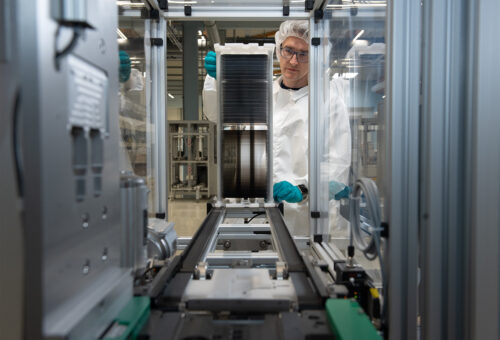Oxford PV has set a new world record for efficiency of a commercial-sized M4 solar cell — an incredible 28.6%, as independently certified by Fraunhofer ISE.
 The cell was made by depositing a thin film of perovskite onto a conventional silicon solar cell. The combined tandem solar cell achieves a conversion efficiency that is substantially higher than that of mainstream silicon-only solar cells, which average 22-24%.
The cell was made by depositing a thin film of perovskite onto a conventional silicon solar cell. The combined tandem solar cell achieves a conversion efficiency that is substantially higher than that of mainstream silicon-only solar cells, which average 22-24%.
The solar cell was produced at Oxford PV’s integrated production line in Brandenburg an der Havel, Germany. The factory has commenced initial production of the company’s tandem solar cells for integration by solar module manufacturing partners and is ramping up to higher volumes. The site, operational since 2017, houses the world’s first volume manufacturing line for perovskite-on-silicon tandem solar cells and employs more than 70 staff.
“Our latest efficiency achievement of 28.6% is more than 1.5% above our record set last year and exceeds our own roadmap plan of 1% annual increases,” said Chris Case, Chief Technology Officer at Oxford PV. “These record-setting solar cells are made on the same production line as our 27% efficient commercial solar cells, which already meet strict performance and reliability targets.”
David Ward, Chief Executive Officer at Oxford PV, commented: “This world record on a large-area cell is our second in two years and marks another milestone for our technology. The achievement also showcases our strong intellectual property and is a testament to the talent and commitment of our team. While we continue to innovate on our perovskite-on-silicon technology on small research-sized solar cells, much of our focus has been on improving our commercial-sized cells for the market, ramping up production, and working with our solar module partners to prepare them for assembly into solar panels. Our team has made excellent progress during 2023 and our innovative solar cells are close to being in the hands of our module-manufacturing customers.”
A spin-out of the University of Oxford, Oxford PV has been developing its perovskite-on-silicon technology based on research-sized cells at its R&D centre in Oxford, UK. Its production facility near Berlin, Germany, is focusing on scaling up and continuously improving the manufacturing of commercial-sized devices, and the company has recently registered a U.S. subsidiary.
News item from Oxford PV





““Our latest efficiency achievement of 28.6% is more than 1.5% above our record set last year and exceeds our own roadmap plan of 1% annual increases,” said Chris Case, Chief Technology Officer at Oxford PV.””
This can’t be ‘in perpituity’ this 1% annual increase per year. I have seen claims that mono crystalline silicon can have a “theoritical” limit of 29% to 30%. So, if advances in crystalline silicon solar PV cells can create cells with much less crystalline faults and other defects one could get to that 30% solar PV cell. Then additional perovskite coating to grab (what?), another 10% to 20% band gap creating the possibility of a 40% to 50% solar PV cell. This begs the question of what the operating parameters will be for tandem solar PV cells. Is ambient temperature in full sun capture have more or the same degradation of output per degree C above 25 degrees C. So, using the PTC rating, would the upper limit of a tandem solar PV cell be 935Wp to 730Wp on any given day? But still on a 400 square foot solar PV array on one’s roof, you could see, 18,700Wp to 14,600Wp and from an average of 74.8kWh/day for a modest 4 sun hours to 58.4kWh/day up to 112.2kWh/day for six sun hours a day to 87.6kWh/day. That is substantial.